Paul MacAlindin's Blog
May 18, 2020
Music in the Time of COVID: first steps
 distributing gift-tech at
distributing gift-tech at Govan & Linthouse Parish ChurchSince UK lockdown on the 23rd March, orchestras all over the world have been trying to grapple with the new reality. Many are finding themselves at the bottom of their government's priority list when it comes to reopening for business. That should come as no surprise - preventing viral spread in a concert hall is an absolute nightmare: the cleaning costs after each concert, the removal of rows of seats from the box office and the hall, reduced size orchestras to accommodate social distancing in orchestra pits and on stage etc. etc. etc.
As a regeneration orchestra, The Glasgow Barons has to respond to the people we serve locally, in this case, Govan, former ship building hub of the British Empire and now area of deep deprivation. Yes, we're fully professional, yes, we're a community orchestra in that our programming is built entirely to address the venues and needs of Govan. No, we're not here for the cheap rates and great transport links, and yes, we do hire people locally, because the only way to reverse deprivation is to put money in people's pockets in exchange for goods and services. Getting people through that long journey to a point where an employer can take them seriously has many steps: volunteering, rehab, training, self-confidence building, counselling or coaching through organisations like Unlock Employment.
During these first few weeks of lockdown, here are some of our first steps.
Musicians in Exile online
Musicians in Exile is our community music project for asylum seeking and refugee musicians. After our weekly rehearsals in Govan were cancelled, the group decided to keep working online. This means weekly zoom meetings to check up on everyone, with three professional facilitators, myself and 12 musicians. It means working online together to create songs such as the Persian number Saaghie Mey Kharan:
BBC Radio Scotland reportage
Quarantine Classics
Secondly, I'm now broadcasting every Sunday at 8pm for Sunny Govan FM community radio as part of a larger home DJ team, providing up to date community info and entertainment for Govan and Greater Glasgow. Why is radio still important? Because it's free and more accessible than the internet. Among the vulnerable groups we reach are:
the Radio Generation, baby boomers who prefer traditional media, or don't want to jump the hurdles of going online Disabled people whose internet access is reduced because their carers are currently less available to them those who can't afford the internet. This includes asylum seekers and refugees, so I offer to top up pay-as-you-go mobiles for anyone in Musicians in Exile who needs it
Gift Tech
Organised through Govan Housing Association, Clyde College's Gift-Tech scheme lends out free laptops and PCs reconditioned from their obsolete stock. Through local referrals from schools and organisations such as Govan Community Project and Kinning Park Complex, people can get online to stay in touch with families, keep kids occupied and make sure they do their online homework.
They can then collect the tech from me at Govan & Linthouse Parish Church from 12.30-2pm every Wednesday.
Whilst internet provision in Govan is less available than elsewhere for reasons mentioned above, coronavirus and information dissemination has forced the issue into the spotlight, and will become more prominent as the Riverside Innovation District, which includes us, begins to take hold.
Published on May 18, 2020 19:56
April 10, 2019
Culture Summit Abu Dhabi - day 3

09:30 – 10:15 What are the new frontiers?Moderated by John Prideaux, US editor, The EconomistSpeakers:Amar Bakshi, Founder, Shared_StudiosMaher Chmaytelli, Head of the Middle East and North Africa breaking news desk,ReutersRicardo Karam, Talk Show Host and Founder, TAKREEM Foundation
Freedom has a price, and journalists, due to new reporting tools for immediacy and openness, receive more threats against life or withdrawal of funding. Arab journalists risk a great deal in going deep into a story. The accessibility of war zones through satellite imagery has brought immediacy, scale and greater detail to areas of conflict and threatened heritage sites. Citizen journalists, bloggers, are hugely important in getting right into an inaccessible area e.g. MosulEye tweeting during the occupation by Daesh. This cannot provide verified material, but information which research from other outside sources can corroborate. Accuracy, speed and fact checking are all top priorities. The open questions, the 5 W and H, are key.Tech institutions like Facebook address us as individuals, not communities. This tends to limit community connectivity and reduce empathy between people - the conversations that used to happen are now about talking rather than listening. Does accessibility really bring inclusion, or create new silos? Does it foster empathy, inspire value and connection between people? Or does the social media cult of the individual kill this?Portal is a project of 40 golden containers around the world where you can walk in and have a live, full body video conference with a stranger in another container in another part of the world, over coffee. Empathy and discussion are promoted.Knowledge in itself is of little value without the teachers, librarians and curators to manage it.
10:15 – 11:00 What constitutes public art?Moderated by Tim Marlow, Artistic Director, Royal Academy of Arts, UKSpeakers:Oliver Beer, ArtistMichael Craig-Martin, ArtistFarshid Moussavi OBE, ArchitectWael Shawky, Artist”
Technology can create grander scales of public impermanent art, through projection or video walls, for example. It's difficult to make something permanent that's deserving of permanence. Place is critical, but so are the people who use the place, not necessarily the elite who judge the art, but the day to day citizens and workers.Bad public art can alienate, lead to indifference, or kill engagement. Most old art is public in that it has passed through generations of owners, and has a collective experience. Public art has been seen as a fix for bad architecture. UK's section 106 forces developers to contribute to public art, with disappointing results. At its worst, public art is propaganda.Public art must engage with one's own time and one's own moment, a fluidity between public and private. Younger public artists are more aligned with social discourse and contact with the consumer, possibly due to social media culture, than older artists, who are primarily focussed on defining space and place.
11:30 – 12:15 How can new technologies support heritage in emergencies?Moderated by Oliver van Damme, Programme Specialist for Planning and Coordination, UNOSATSpeakers:Dr Emma Cunliffe, Research Associate, Cultural Property Protection and Peace, Newcastle UniversityKristen Parker, Cultural Heritage ConsultantYves Ubelmann, President, ICONEMMartin Roeske
Satellite and drone imagery can home in on details and show scale in unprecedented ways, without the danger of being present. This can become a tool to generate public support for heritage sites in danger.Digital copies of heritage objects and sites can connect people and diasporas to heritage, with refugees adding to the granularity with their own photos and narratives saved on facebook and smart phones. Thus the citizen archivist can contribute.Augmented reality can bring together disparate collections and offer an immersive virtual exhibition of places too dangerous to visit. Apps can create instant recording and monitoring of sites for new damage or looting, with instant connection to experts for on site advice. Trauma can also be dealt with in conflict zones through mobile apps, for those working on site. Facebook and other platforms have virtual memorials to damaged/looted sites for diaspora communities. Trust needs to be built with displaced persons, refugees and diasporas to rebuild an archive of damaged sites. Slow attrition through wear and tear or neglect is as important an issue as sites damaged by war.Asrak is a project of MIT and Metropolitan Museum of Art, sharing heritage digitally with refugees.Block chain technology can trace and source artefacts that surface on the art market, shutting down black market trading in auction houses. Sniffer dogs are being trained to identify different soil types in Syria, Iraq, and other conflict zones, to identify the origin of smuggled antiquities.3D renderings and printing can rebuild damaged or destroyed artefacts and enhance the emotionality of heritage.
12:15 – 13:00 How are the new publics shaping our new museums?Moderated by Richard Armstrong, Director, Solomon R. Guggenheim Museum and FoundationSpeakers:Madeleine Grynsztejn, Director, MCA ChicagoSuhanya Raffel, Director, M+, Hong KongAaron Seeto, Director, MACAN, JakartaKulapat Yantrasast, Architect, WHY
Dialogue is the conduit with the community, building wonder and civic commitment - artist activated, audience engaged, participatory.Museums need to stop competing against modern life, and align with it. From temple of culture to platform for energy. Building empathy in diversity is the new goal, for publics to see themselves in the art. Art fair explosions, especially in the far east, has raised awareness.However, there is no appetite for crowd-sourced curation. The role of the expert is still to fashion an exhibition with insight and appeal.How do we get people to like/love one another? Museums as meeting places, match makers, for people to share and enjoy each other, as well as art. Museums as places where people can feel their own sense of being. A place where being slow, slowing down, reflecting, is valued.With Millennials, the intersection between institutional and personal values needs to be total. In the US, they are about to receive a massive transfer of wealth from baby boomers, making them important consumers and sponsors. "Nothing about us without us".Curational rigour is about translating the artistic experience for the audience, creating curiosity and respect from place to platform.
Published on April 10, 2019 03:29
April 9, 2019
Culture Summit Abu Dhabi - day 2

09:30 – 10:15 Representing the world: How can the media drive change?Moderated by John Prideaux, US editor, The EconomistSpeakers:Neha Dixit, Independent Journalist, IndiaCarolina Guerrero, Journalist, Radio AmbulanteKaren Okonokwo, Founder, TONL Media
Media can portray minorities, marginalised groups and people who of different cultures to boost diversity. This is counter to the target audience driven model of media, which may only encompass one demographic.Podcasts can provide methods of reportage driven by the subjects of the stories themselves. This can run counter to the western white narrative of decades, and can change the narrative. It may also require years of persistence to create a single story.Education is not the answer, as many highly educated journalists produce culturally narrow or divisive journalism. Instead, affirmative action is proposed.Journalists face considerable risks in reporting non-mainmstream narratives. Reaching marginalised groups, for example trafficked children, can be very time consuming and dangerous. Travelling outside cosmopolitan areas requires a decentralised approach to narrative building. Political threat can be increased by investigation in rural settings. Police violence in India, for example, is easier for the police to cover up in isolated settings. Unconscious bias requires time to pinpoint, asking investigative questions, building empathy and avoiding knee-jerk lines of questioning. Targeting new demographics before they become big e.g. Generation M - by 2050 Muslim Millennials will have 25% of the world's purchasing power. The corporate political nexus generates deliberate fake news in line with their agendas, and newsroom fact checking, under increasing pressure, becomes less.
10:15 – 11:00 What is the role of heritage in post-crisis recovery and reconstruction?Moderated by Dr Shadia Touqan, Director, Arab Regional Centre for World HeritageSpeakers:Anne-Marie Afeiche, Director, National Museum of BeirutPaolo Fontani, Director of the UNESCO Office in BaghdadAli Ould Sidi, Adviser, Ministry of Culture, MaliRebuilding of Mosul through UNESCO will involve 3,000 local residents on apprentice schemes, to deliver semi-and highly skilled reconstruction work of historic monuments. Non-skilled work e.g. rubble removal, will also stay local. Tendering construction contracts will contain clauses which require local employment and training. Local communities can experience revival and become centres of economic and social development if included in consultation and reconstruction. They have been care takers of their heritage long before the invention of the modern nation state.
11:30 - 12:15 How can museums activate the past in our present?Moderated by Alexandra Munroe, Senior Curator, Asian Art, Solomon R. Guggenheim Museum; Interim Director, Curatorial Affairs, Guggenheim Abu DhabiSpeakers:Apinan Poshyananda, Artistic Director, Bangkok Art BiennaleAntonia Carver, Director, Art JameelWanda Nanibush, Curator of Indigenous Art, Art Gallery of Ontario, TorontoShahzia Sikander, Artist
Contemporary art is an orthodoxy. The roots of modernism, as with Kandinsky, ignore his knowledge of 14th century Buddhism. The modernist arts agenda is a teleological mess, whereby linear time lines and collections partitioned by schools or categories, impose a narrative unattached to the artist's original message.Australia and Japan in the 90s started breaking away from this by allowing artists their own contextually and arenas. The tyranny of the present is our display culture, meaning that we seek to make relevant modern art, regardless of its complex and textured roots. The concept of authenticity versus inauthenticity is made complex by indigenous narratives. What is "authentic"? Is this ideologically fixed? "Indigenous" is simply a label made for the convenience of colonising societies. To break western linear identities, curation can become mercurial. How can we become more mercurial?How does the specific relate to the universal? "If you're not going to take the politics, you can't have the spirituality"(off indigenous art).Picking up pieces of the past, whose narrative may have been cut short, in the present, creates a new narrative for the future.
Published on April 09, 2019 03:35
April 8, 2019
Culture Summit Abu Dhabi - Day 1

09:30 – 10:10 Opening Panel: Cultural Diplomacy and Responsibility in the Age of New TechnologyModerated by HE Zaki Nusseibeh, Minister of State, UAESpeakers:HE José Luis Rodríguez Zapatero, Former Prime Minister, SpainHE Jorge Fernando Quiroga, President of Bolivia (2001-2002), Member of the Club de MadridBernardino León, Director General, Emirates Diplomatic Academy
Culture helps us to understand the other when faced with divisions in society through protectionism and isolationism. It broadens our thinking to prevent us becoming trapped in the "echo chambers" of social media commentary, where like minds reinforce each other without debate from opposing views. Culture is an antidote to intolerance. Big data, the Internet and artificial intelligence can all be utilised to promote co-existence, whilst reinforcing the digital rights of copyright holders.The tension between the "cultural elite" and populist movements such as BREXIT and Trump, can be eased through the application of cultural diplomacy, promoting human rights and mutual respect through the arts.However, the echo chambers of the elite also need to be challenged. A performance of Forza del Destino in Italian with a multinational cast to a multilingual opera audience can happen simultaneously to protests on the streets, without either side recognising the existence of the other.
Latin America is showing greater growth than the G7, and the fear of those who do not look like you is fuelled by populist politicians through racism. Media can play a role in creating tolerance.
As jobs are displaced by technology, it is easier to blame someone who is not like you, than a machine or programme. So, cultural awareness of the other through media has an important role in building respect and understanding.
10:10 – 10:50 How can media survive the age of technology?Moderated by John Prideaux, US editor, The EconomistSpeakers:Mina Al Oraibi, Editor-in-Chief, The National, UAEJohn Defterios, Emerging Markets Editor & Host, Marketplace Middle East, CNNShashi Menon, Founder and Chief Executive Officer, Nervora”
Technology has made media multi-platform and Millennials need immediacy with multiple perspectives simultaneously. Newspapers now no longer "go to press" as the story is continually being updated.Smart phones pack technology that used to be carried in multiple suitcases, and make immediate reporting easier. Editorial decisions are focussed on immediacy, issues people care about, and, due to the massive amount of online noise, curation of stories matters more than ever. Topics of importance need to be given air time, as more popular stories can overwhelm them. Fact checking is much more important than ever before, to combat the "echo chamber" of social media. Social media is not the same as media, and recent research shows that American consumers now trust social media less than politicians. However, an editorial decision to fact check a story can inadvertently give undue airtime, rather than simply letting it slide. The "Echo chamber" effect can create a feedback loop which spawns new pseudo-realities for siloed followers of social media.All of this puts ever more strain on limited resources.Populism can quickly become a competitive race to the bottom, with less editorial time available to take a step back and reflect on the deeper picture and put stories into meaningful contexts.Off-line is the new online. People, notably Millennials, remarkably show a preference for print, with various tablet editions proving less successful than predicted. There's an enduring emotionality and depth to print, you can lean into it, as well as durability - you can tear it, break it, drop it, and it's still usable. However, audio and personalisation of newsfeeds is still important.Myth - tech is the saviour of media.Freelancers are becoming far more important to editors as enterprise journalism brings hidden gems of stories to light.
11:20 – 12:00 How can museums creatively embrace the digital age?Moderated by Troy Therrien, Head Curator of Architecture and Digital Initiatives, Solomon R. Guggenheim MuseumSpeakers:Lizzy Jongma, Senior ICT Project Leader, GLAM (Dutch Digital Network for War Collections WW2)Emeka Ogboh, ArtistApinan Poshyananda, Artistic Director, Bangkok Art BiennaleKudo Takashi, teamLab, Artist collective/Digital Art Museum, Tokyo
Authenticity can be used as an excuse not to do anything. "Come to us to see the real thing. We don't need to show you a digital 3D version." Digital is seen as outside the comfort zone of museums, whose main focus is to invite people into their curated space on their terms.Entire collections are now appearing in the digital environment, whereas previously only a percent would be on display, the rest in boxes. This is crucial for countries whose cultures were appropriated during imperial times and whose citizens find themselves thousands of miles away from the original. An interesting case in point is Egypt, which has been seen not to protect its cultural heritage in times of crisis.Attempting to reach the pinnacle of digital success is also to be avoided, as the draw of experiencing something online has been shown to motivate people to experience the real thing. In the Netherlands, a massive WW2 curation project has digitised thousands of pieces of evidence from across the country, and through semantic technology, has built detailed pictures of individual lives from fragments dispersed throughout the museum system.The emphasis here is on understanding the world through physicality and bodies, how they relate to the objects on record, how the lives around the objects were experienced on a personal level.
12:00 – 12:40 How can we define popularity vs. populism?Moderated by Tim Marlow, Artistic Director, Royal Academy of ArtsSpeakers:Farooq Chaudhry OBE, Producer, Akram Khan CompanyMunira Mirza, Executive Director, Culture, Kings College London, Former Deputy Mayor for Culture and Education, Greater London Authority, UKLars Nittve, Curator, Art Critic, Writer. Former Director Tate Modern, M+ Hong Kong, Moderna Museet Stockholm, SwedenThe dialogue between artists and the public is not a zero sum game, but rather a continuum where both can benefit. The audience is not to be sen as the recipient of culture, but the final collaborator. People want "flesh, blood, space and oxygen"The role of the expert in predicting what is popular is often wrong, or skewed, but there still needs to be that curator to take the risks and experience the trials and errors. The public needs to be able to trust the expert to curate well and wisely. Ultimately, one has to let people decide for themselves what works and what doesn't. This requires intention, action and context.Institutional communication between themselves and with their public is important.Often, an artist may spend decades finding their voice, only to have to lose it again when people expect it to be repeated as the new formula for that artist's success.
12:40 – 13:20 Why is heritage a priority in crises?Moderated by Lazare Eloundou, Director for Culture and Emergencies, UNESCOSpeakers:Alexander Kellner, Director, National Museum (Rio de Janeiro), BrazilMarylene Barret Audouin, Cultural Heritage Conservator, iTEAla Younis, ArtistPeople identify with their heritage. Heritage helps us define ourselves as humans. Heritage and human involvement are essential to meaning. In times of crisis, destroyed heritage can be seen as a powerful opportunity to initiate institutional change e.g. museums as institutions; if you don't change the institution, you don't change the country.
Published on April 08, 2019 12:41
June 26, 2018
Musicians in Exile
 With the second of the three Govan Old Parish Concerts successfully done and dusted last Friday, I'm turning my attention to the next Glasgow Barons project, Musicians in Exile, which starts on Monday in the Pearce Institute with Calum Ingram. Here we are strutting our pitch:
With the second of the three Govan Old Parish Concerts successfully done and dusted last Friday, I'm turning my attention to the next Glasgow Barons project, Musicians in Exile, which starts on Monday in the Pearce Institute with Calum Ingram. Here we are strutting our pitch:Musicians in Exile began as a project called Musiker in Asyl, in Allerweltshaus in Cologne, back in 2003. Every Saturday morning, I'd strap my 7 octave electric piano over my shoulder and travel through the subway to Körnerstrasse, to open the premises up at 11 am.
There, almost without fail, would stand the smiling Mahyar and Bijan, asylum seekers from Iran, who played electric guitar and violin respectively.
Musiker in Asyl offered Cologne's musical asylum seekers a weekly rehearsal, with the chance to recover their intrinsic cultures, work with others, practise their German and put group performances out there into the community, to build new, hopeful relationships with the good Burgers of Cologne.
I found these musicians through 3rd sector organisations Diakonie and Caritas, who are the charitable arms of the Protestant and Catholic churches respectively. They knew the people who would benefit most from the project, and the pressure they were under. 91% of Asylum seekers had their cases rejected, and were sent back.
Many musicians came and went, but Mayhar and Bijan held out, week after week. Mahyar was called Aliyresa back then, and changed his name to Mahyar, a more traditional persian name, over the course of the project.
His death metal band Oxydox, had been filmed in an illicit underground concert in Teheran. All the band members were arrested and threatened with 7 years in prison. They left their families behind and escaped to Germany, where they claimed asylum. The problem wasn't the musical idiom, per se, but that any songwriter in Iran had to run the lyrics by 3 Mullahs before the songs could be performed in public. Being anti the Iranian regime, they didn't, and Mahyar was arrested.
When he arrived in Cologne, he was in a bad way psychologically, and living in an asylum dorm on the outskirts of the city. I got down to asking around for instruments for him and Bijan, who was still only 16, and had arrived with his dad.
As the rehearsals flowed, his objective was clearly to practice his forbidden music; thus, I became an expert in Persian Death Metal, learning to vamp chords on the piano written from right to left over his lyrics, which being in Farsi, I couldn't read. Of course, we made it work, such is the power of music to communicate across cultures.
As our friendship deepened, so our collective musicianship evolved. Week after week, regardless of how lousy we felt, we hauled ourselves along to Allerweltshaus on a Saturday morning to keep the fragile group alive. There was one day, out of the blue, when the whole building lit up with music. Herr Bestvater, an elderly German who could only speak Russian, turned up with his accordion, and rattled through the florid folk repertoire, issuing random expletives. Kijan, highly gifted flamenco guitarist from Iran, popped in and started jamming. Others simply arrived, drank tea, listened, wandered from room to room, absorbing the smorgasbord of musical styles.
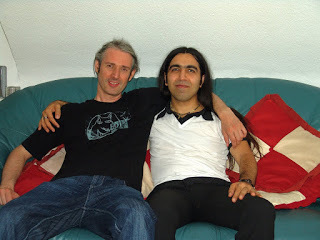 Me and MahyarOne rehearsal, with only Mahyar and myself, lasted four straight hours of electric guitar and piano improvisation. Musiker in Asyl had gone beyond a psychosocial music project, and become an exorcism of Mahyar's traumatic musical journey to Germany. Shortly after, his court case for asylum in Germany came up, and he was granted permission to stay. A favourable factor was his participation in Musiker in Asyl, where he had practised his German with us, turned up religiously and joined us in our many al fresco performances around town.
Me and MahyarOne rehearsal, with only Mahyar and myself, lasted four straight hours of electric guitar and piano improvisation. Musiker in Asyl had gone beyond a psychosocial music project, and become an exorcism of Mahyar's traumatic musical journey to Germany. Shortly after, his court case for asylum in Germany came up, and he was granted permission to stay. A favourable factor was his participation in Musiker in Asyl, where he had practised his German with us, turned up religiously and joined us in our many al fresco performances around town.So, as they say, here we go again. My partner in crime, Calum, is absolutely the right person to have on board, and his colleague, Ali, a Persian drummer who has lived in Edinburgh for 20 years, will also join us on the mentoring team. We'll run this as a pilot project for 8 weeks, with a workshop performance at the office of our partners, Govan Community Project.
Last week was pretty exhausting, what with organising The Glasgow Barons' Govan Old concert and running around the Scottish Refugee Festival with flyers in Arabic, Farsi, Sorani Kurdish and English, where I would most likely meet prospective participants. Here's an article about us from The National:
Paul MacAlindin: The award-winning musician helping refugees
Mahyar now lives with his wife and daughter, who followed him rom Teheran, in Cologne, and runs GITARRENPULS, a guitar school. Here he is, on the left, playing in the Rebellisches Musikfestival.
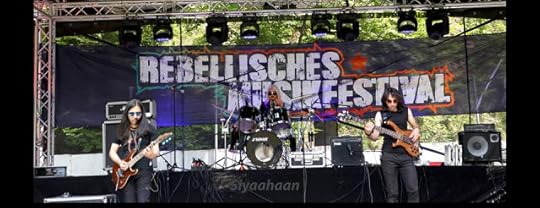
Watch this space.
Published on June 26, 2018 14:31
May 5, 2018
The Govan Renaissance & The Glasgow Barons
Some pics from Thursday. Come and hear us again on 22nd June in Govan Old Parish Church for STRAMASH!
 Ainsley Hamill sings Songs of Govan Old part 1. Parts 2&3 are on 22nd June and 26th July
Ainsley Hamill sings Songs of Govan Old part 1. Parts 2&3 are on 22nd June and 26th July
 David Juritz catching fire in The Four Seasons
David Juritz catching fire in The Four Seasons
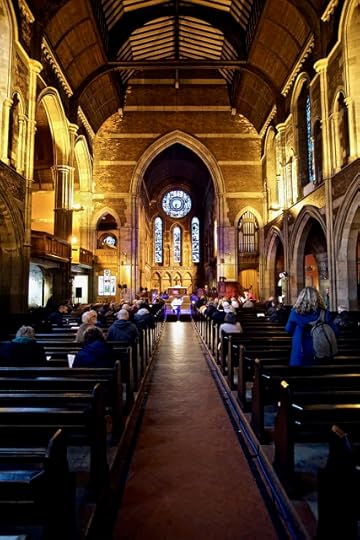 warming up in Govan Old
warming up in Govan Old
 Conducting away, happy as a clown
Conducting away, happy as a clown Working in the beautiful surrounds of Govan Old
Working in the beautiful surrounds of Govan Old obviously a big moment
obviously a big moment in the lovely Govan Old Parish Church
in the lovely Govan Old Parish Church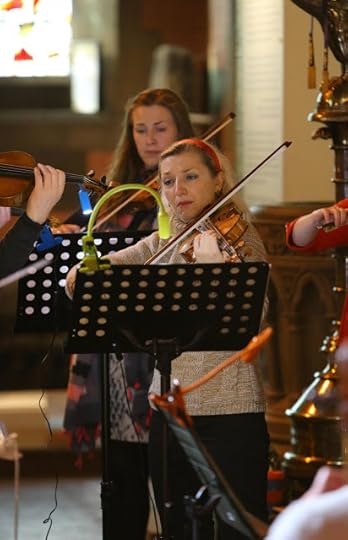 the wonderful players of The Glasgow Barons
the wonderful players of The Glasgow Barons with one of the many fabulous Govan Stones, here a 10th century Viking Hogback
with one of the many fabulous Govan Stones, here a 10th century Viking Hogback packing as many musicians as possible into the front of the church
packing as many musicians as possible into the front of the church
 Rehearsing Elgar's Serenade for Strings
Rehearsing Elgar's Serenade for Strings
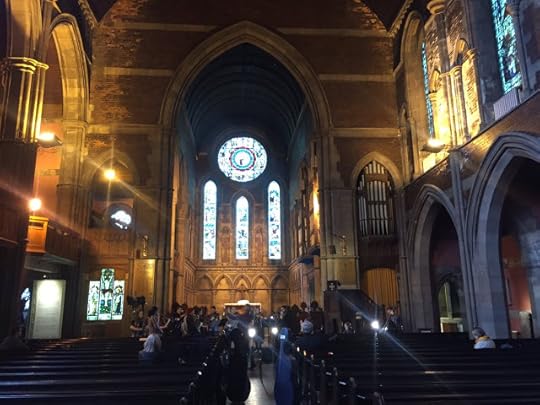 Rehearsing in Govan Old
Rehearsing in Govan Old
 Ainsley Hamill sings Songs of Govan Old part 1. Parts 2&3 are on 22nd June and 26th July
Ainsley Hamill sings Songs of Govan Old part 1. Parts 2&3 are on 22nd June and 26th July David Juritz catching fire in The Four Seasons
David Juritz catching fire in The Four Seasons warming up in Govan Old
warming up in Govan Old
 Conducting away, happy as a clown
Conducting away, happy as a clown Working in the beautiful surrounds of Govan Old
Working in the beautiful surrounds of Govan Old obviously a big moment
obviously a big moment in the lovely Govan Old Parish Church
in the lovely Govan Old Parish Church the wonderful players of The Glasgow Barons
the wonderful players of The Glasgow Barons with one of the many fabulous Govan Stones, here a 10th century Viking Hogback
with one of the many fabulous Govan Stones, here a 10th century Viking Hogback packing as many musicians as possible into the front of the church
packing as many musicians as possible into the front of the church
 Rehearsing Elgar's Serenade for Strings
Rehearsing Elgar's Serenade for Strings
 Rehearsing in Govan Old
Rehearsing in Govan Old
Published on May 05, 2018 09:46
April 30, 2018
Serenades of Govan Old
 Ainsley HamillThe opening concert of The Glasgow Barons in 2018 is finally upon us. On Thursday 3rd May, we begin our three-concert arc, Serenades of Govan Old, in Govan Old Parish Church.
Ainsley HamillThe opening concert of The Glasgow Barons in 2018 is finally upon us. On Thursday 3rd May, we begin our three-concert arc, Serenades of Govan Old, in Govan Old Parish Church.Get your tickets online here:
Four Seasons in One Day - 3rd May
Stramash! - 22nd June
Heaven and Earth - 26th July
I'm inviting two different audiences to attend:
The good people of Govan, otherwise known as Govanites, some of whom have never visited Govan Old before, or heard an orchestra live on their doorstep.
The good people of Glasgow, who regularly attend concerts, but would never visit an area of multiple deprivation to do so.
The purpose of these concerts is to bring people together through the power of music in an historic venue, the site of Scotland's first mainland church, founded back in the 6th century AD. Govan needs new people, visitors, impulses, creativity. This comes in many forms, and mine is by founding an orchestra.
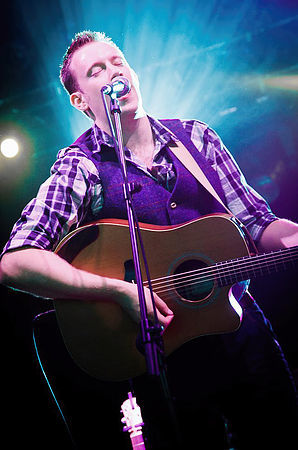 Norrie MacIverOur concerts have two themes: first, the Serenades of Elgar, Tchaikovsky and Dvorak, and second, the Songs of Govan Old. These are 10 songs commissioned by the Glasgow Barons from Ainsley Hamill and Norrie MacIver about Govan's heroines and heroes, with much input from the Govan Reminiscence Group. They're celebrating their 30th anniversary, so what better than to revive Govan's heritage in living song.
Norrie MacIverOur concerts have two themes: first, the Serenades of Elgar, Tchaikovsky and Dvorak, and second, the Songs of Govan Old. These are 10 songs commissioned by the Glasgow Barons from Ainsley Hamill and Norrie MacIver about Govan's heroines and heroes, with much input from the Govan Reminiscence Group. They're celebrating their 30th anniversary, so what better than to revive Govan's heritage in living song.Scottish composers, Alasdair Nicolson and Bill Sweeney, are also in the mix. We're performing such compositions as Stramash, An Og Mhadainn and Sean Orainn, music rooted in the salt of Scotland's earth and water, sound-masters who really know how to breathe new sonic life into old cultural truths.
Spreading the word about these concerts requires a real knowledge of Govan's many communities of interest. I've just come back from talking to the Govan & Linthouse Church Guild, and tomorrow night, I'll be at the Scottish Police and Community Choir rehearsal at the Pearce Institute. All the pubs along Govan Road have taken posters, as well as the Bohemian corner, Cafe 13. 7,500 pamphlets are being distributed through Glasgow till July, as well as coverage from STV news and an ad in yesterday's concert with the Royal Scottish National Orchestra.
To get a taste of this unique event, watch Ainsley below as she meets Govan Reminiscence Group for the first time. Subtitles available for foreigners who haven't mastered Glasgow dialect yet.
Published on April 30, 2018 14:52
January 2, 2018
The Glasgow Barons - Year Zero (the long read)
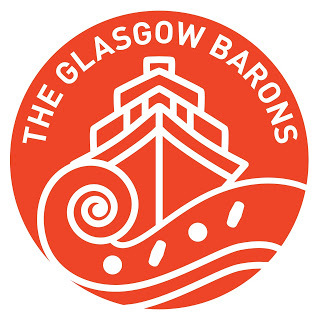
The Glasgow Barons are the world's first professional orchestral ensemble for helping rejuvenate an area in trouble, in this case, Govan, the ship-building district of Glasgow, Scotland.
Govan, Ward 5 of Glasgow City Council, is where I now live. Once the base of Scottish Christendom, the ancient Kingdom of Strathclyde and Viking settlers from the 6thto 11th centuries AD, it became the world’s biggest shipbuilding hub for the British Empire. Since that industry's decline, Govan has become an area of deep multiple deprivation. Many excellent agencies like Central Govan Action Plan, Sunny Govan FM, Plantation Productions and Govan Heritage Trust work tirelessly to lift it out of the water again.
THE LOGO & NAMEOur logo had its own journey. Commissioned from Cassia Friello, we worked intensively together to create the feel I was after.
Initially, she came up with beautiful images inspired by ship building and Celtic knot work. I changed the direction of the colour away from blue to orange; "less Bombay Sapphire, and more Irn Bru, please." After the logo's community consultation, three issues came up. It needed to be more obviously musical, the colour reminded some people of The Orange Order, and some women found the ship too masculine and past-oriented.
The resulting iterations have led us to the current logo. Orange is the colour of the sun shining on Govan's Victorian sandstone buildings, as it occasionally does. Much research has gone into which colours a Glasgow business should avoid to remain apolitical, and the only "safe" colour is - brown.
So, I stuck with orange.
Secondly, there is an obvious perception of masculinity in shipbuilding, though this belies the lore that ships are considered female. Our ship is a nod to Govan's dominant heritage, which nobody here can escape, and also the fact that shipbuilding is driven by innovation; here, Robert Elder's compound engine and integrated shipyard. The Glasgow Barons must constantly innovate to meet our challenges, envisioning forward like the ship builders. Finally, the shipyards, along with our ancient Christian heritage, connected Govan to the world, and doing so meaningfully through music is especially effective.
The violin scroll completes our logo: a wave of water, sound and craftsmanship.
And the name?
Glasgow, because of where we are, though our focus is Govan.
Barons after the ship-building barons, who were the last generation to irrevocably shape Govan through hard work and innovation.
2017 - June 3rd: LUATH STREET PARTYOn arriving here late 2016, a few things struck me. First, I sensed a lack of trust, a passive aggressiveness not just between inhabitants but also 3rd sector agencies. My street was littered with rubbish. At the end stands the shipyard, which used to employ everyone in Luath Street, and now employs none. No kids played here. My block of tenement flats, petitioned to be built in 1900, was meant for the bowler hats who worked in Fairfield shipyard's middle management and the draughtsman's offices round the corner, and included radically progressive indoor toilets and bath tubs. Now, by the residents' own admission, it's a dumping ground. So, after trying to attract residents' support, I worked alone with Govan Housing Association to create The Luath Street Party. We blocked off the street to traffic and made a kids’ play area for the likes of hop-scotch, skipping and sandcastle building. We set up a craft and heritage zone with T-shirt printing, bracelet and ceramic tile making, face painting, science games. Glasgow Open Museums came with a casket full of 19thcentury domestic curios whose function people had to guess. Our fantastic music line up had the Govan Allsorts Choir, folk singer/songwriter Paul O’Brien, BBC Young Folk Musician of the Year 2016 Mohsen Amini, The Apparells, Foggy City Orphan and DirtyLoveClub.
In spite of local incredulity that Luath Street could achieve anything, it seemed that all the participants of the party had a great time, and relationships between us all began to soften. We opened up a bit and started talking to each other.
Far more significant, however, was the sheer number of people who didn’t come out of their flats to participate in a completely free arts and craft event right on their doorstep. We saw adults and kids looking down on us from their living room windows. I’m bored of hearing about how the Scottish arts need to be “more accessible”, whatever that means. It's a decades' old blackmail refrain to reduce artists' self-esteem to the lowest common denominator so that we become more malleable, desperate, more afraid of losing funding. In Germany, where I lived for 15 years, people simply wouldn't understand because artists do not need to justify their existence, which is why our cultural politics are baseline at best, and theirs are highly evolved.
So we put everything on everyone's doorstep for free, and many still didn't walk those few steps down onto the street to participate. What exactly should I have done differently? And why is this? It’s about some of the reasons Govan is where it is; long-term unemployment conditions people to stay at home where it’s cheaper and safer. Consumption of drugs, alcohol and daytime telly stay behind closed doors, and the police's intermittent presence would have been noted.
At the Luath Street Party we were more than happy to show our best side to each other, though those who didn't made a decision that has been keeping them alive for years. Poverty is tied to fear, shame, hopelessness. People make poor choices if they're inured to a climate of learned helplessness, where no matter what you do, you end up beaten and thwarted.
Nobody is born to make bad choices, and the arts can be one very powerful piece of a strategic jigsaw that helps turn this around, but those multi-agency conversations, finding out how we work together for change, need to keep happening. Parachuting into an area of multiple deprivation without continually leaning into the discomfort, aka trickle-down outreach, might temporarily kindle hope in a few, but doesn’t sustainably or systemically change anything; and Govan is the proof.
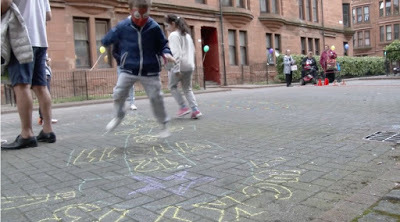

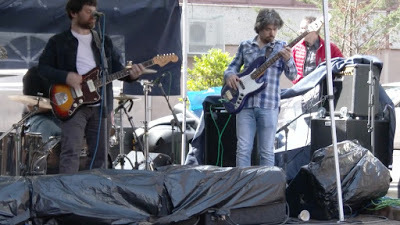
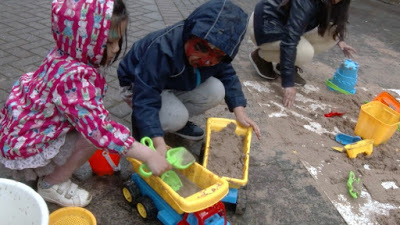


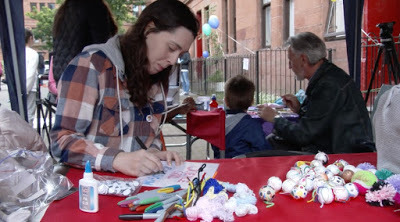
June 4th: Songs of Harmony RowThe Glasgow Barons' first full concert, Songs of Harmony Row, was in Govan Old Parish Church. Our 14 piece string ensemble funded by Creative Scotland filled the clear 19th century acoustic with the glorious Warlock Capriol Suite and Tchaikowsky Serenade for Strings.
In between these, I invited Paul O'Brien, an Irish singer/songwriter living in Holland, to perform his songs based on Govan's folk heritage. Paul travels round Europe's shipyards, Gdansk, Dublin, Belfast, Govan and so on, researching the stories and turning them into songs. Although this hybrid concert format was very raw, it hit home to the local audience, who had never heard a professional string orchestra or folk songs of Govan being performed in their local church before. We reframed the potential of the venue and opened people's ears up to new possibilities.
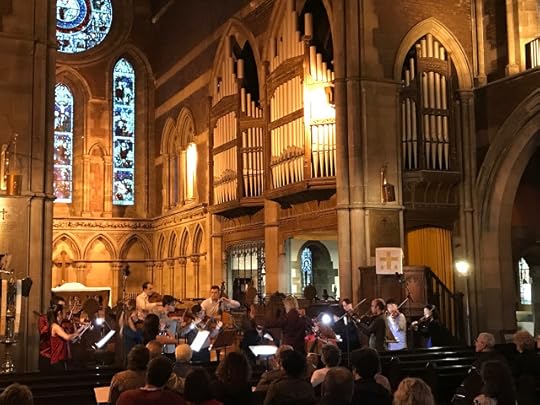
One audience member captured the excitement:
“The Glasgow Barons Concert, performed in the magnificent setting of Govan OldParish Church, was an absolute knock-out and a wonderful introduction to thepeople of Govan and its community, to the power and intensity of emotionsevocative in Classical Music, from "Rousing Cheer", to "Calm serenity". Please,please, let us have more of this! Bravo Paul!”
Lesley Robertson – Music Director of Govan Allsorts Choir
August to December: GOVAN HIGH COMPOSERSEvery Friday during term time, composer Jennifer Martin visited Govan High Music Department. The fourth years needed to write compositions for their exams, and Principal Teacher Elaine Bonner allowed Jennifer to guide them through her process. Making fundamental choices about rhythms, modes, notes and story-led structures, Jennifer guided the kids through the act of their creations, providing the tools and frameworks to help them write entirely original pieces from scratch, devoid of pastiche or electronic instruments.
Three of the Glasgow Barons, Alex, Anthea and Jonathan, visited the kids' classroom at the end of September to introduce the possibilities of writing for bassoon, clarinet and percussion.


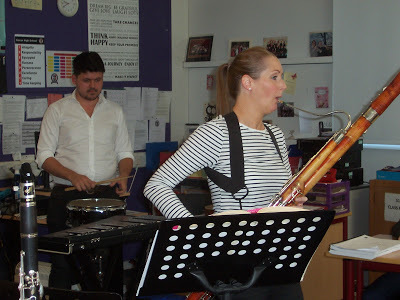
On December 5th, the young composers gathered in the main hall to hear their compositions being played and recorded for their exam submissions. The Glasgow Barons topped and tailed the show with movements from Stravinsky's Octet. Why this? First, as the school teaches wind rather than strings, it made sense to play a wind piece; second, the Octet is hugely entertaining, chopping and changing between blocks of brilliantly constructed wit and character, whose charm hide a very sophisticated structure. Finally, we bring artistic excellence at relatively low cost to an aspiring area of Glasgow. You either believe in others' human potential to the point where the follower surpasses the leader, the student the teacher, or you're part of the problem.
The reception from roughly 100 kids, including invited P7s from Pirie Park Primary School, was rapt, and the applause generous. The P7s, who will come to Govan High next year, now believe the school has its own professional orchestra. That's a very high expectation to meet.
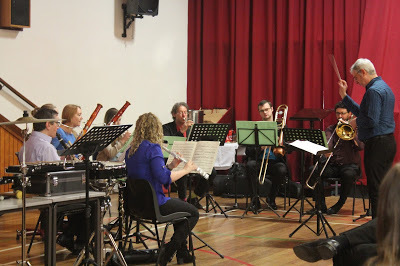
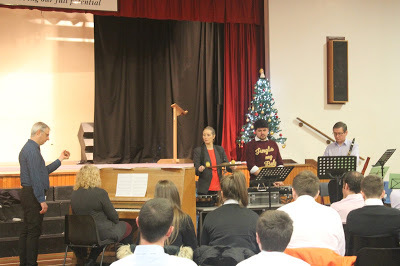
We're deeply grateful to Music Department teachers, Mrs Bonner and Mr Rogers, for giving us the trust to work with their pupils on composition over a whole term. We couldn't have done it without support from The McGlashan Charitable Trust, along with much personal subsidy from us freelance musicians. We're sure we'll be back next year.
The Glasgow Barons' mission is simply to make more music for Govan. That ties into building civic pride, community, skill development, listening, communication and self-confidence. Most of all, it's about collaboration with other agencies to get folk out of hopelessness and into positive life destinations, specifically, jobs.
Upon these three pilot projects, we intend to build our activities. I'm beginning a new journey, one possible direction for orchestras today. Simply put, I'm confronting my reality and responding musically. If we musicians can't do that, what good are we?
Links:
Donate 100% to The Glasgow Barons
www.glasgowbarons.com
Recent Press:
The National
The Herald Scotland
The Sunday Post
The Daily Record
Published on January 02, 2018 17:02
December 13, 2017
Global Blue Ocean Shift Award
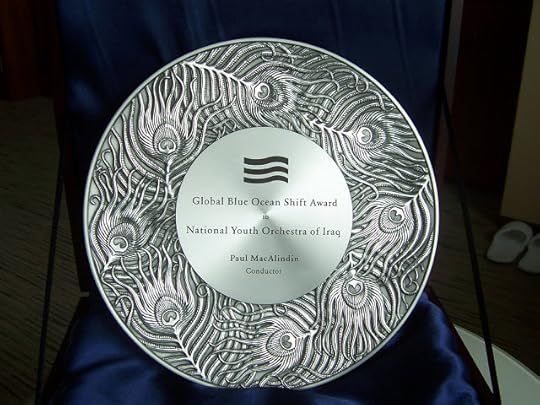 Global Blue Ocean Shift Award
Global Blue Ocean Shift AwardI'm here in Kuala Lumpur two days after receiving the first Global Blue Ocean Shift Award from Najib Razaq, the Prime Minister of Malaysia.
Blue Ocean Shift (2017) is the outrageously successful follow-up from Blue Ocean Strategy (2005), already a New York Times, Wall Street Journal and USA Today bestseller. The National Youth Orchestra of Iraq and I are cause studied on page one of chapter one.
What this award proves is that anyone, from any background, even under the worst circumstances, can make a difference and become a leader in innovative thinking. I'm deeply indebted to Professors Kim Chan and Renée Mauborgne for telling the world about our extraordinary story. Without fully realising it, we were using Blue Ocean Shift to create a strategic arc that ensured our survival for the five years we operated.
The energy and passion I've experienced here at the Global Entrepreneurship Community Summit from the 15,000 delegates, has been extraordinary; outspoken, intelligent young men and women taking the future into their own hands and breaking down barriers. Needless to say, it takes the global business community in ASEAN to recognise merit, creativity, hard work and entrepreneurial risk taking. I've already written extensively on this blog about Blue Ocean with NYOI, so it just remains to share with you some pictures from two days ago.
You can learn about our story in UPBEAT: the Story of the National Youth Orchestra of Iraq, the perfect Christmas present for loved ones and musical pals
Published on December 13, 2017 18:43
September 16, 2017
Where are they now?
As the Kurdish independence referendum comes up on the 25th September, and Blue Ocean Shift, released on the 21st, case studies the National Youth Orchestra of Iraq, here’s a brief summary of what the musicians are doing today.
Alan Kamil – our concertmaster from 2013, is studying Masters at the Royal College of Music in Stockholm.

Dua’a Al Azzawi, (oboe), Ranya Nashat, Ali Mahdi, Mohammed Saad (horns), Murtada Aziz (trumpet), Mohammed Adnan, Ali Al Ghabban, Annie Melconian (violins), Ahmed Abbas (bassoon), Tuq’a Al Waeli, Hussam Ezzat (cellos) continue to play in concerts of the Iraqi National Symphony Orchestra in Baghdad. Hussein, our Baghdad clarinettist from 2013, claimed asylum in Finland.

Murad and Burcu Saffar (bassoons) got married and now live with their son in Turkey.

Mariwan Ismael (clarinet) did a runner in 2011 after Beethovenfest, and is now believed to be living in Sweden. He was the only one we "lost".
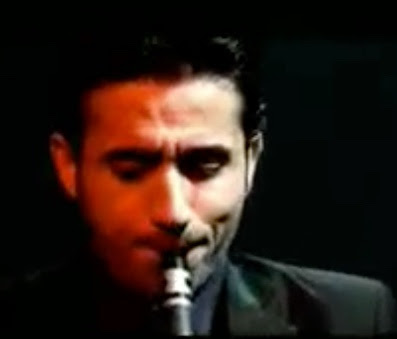
Frand Nashat is a professional translator in Baghdad and still plays his trumpet, most recently in a masterclass in Germany.
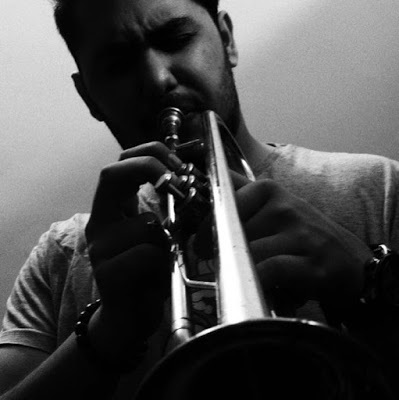
Waleed Assi teaches and plays flute in Suleymaniyah.
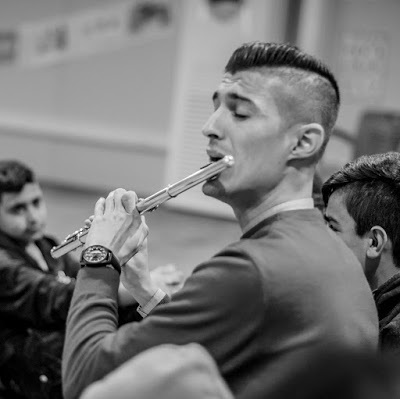
Boran Zaza (piano) studies piano at the Schulish School of Music at McGill University, Quebec and is one half of the piano duo, Duo Columbus.

Siamand Mohammed (bass), Zana and Rezhwan Jalal (violin & viola), Rebaz Sdiq (violin), Awder Mahmood, Hersh Mohammed (cello), Peshawa Mohammed (percussion) and many others still perform in Suleymaniyah, Kurdistan.
Shirwan Mohammed (violin, viola, daff) claimed asylum in Vancouver.
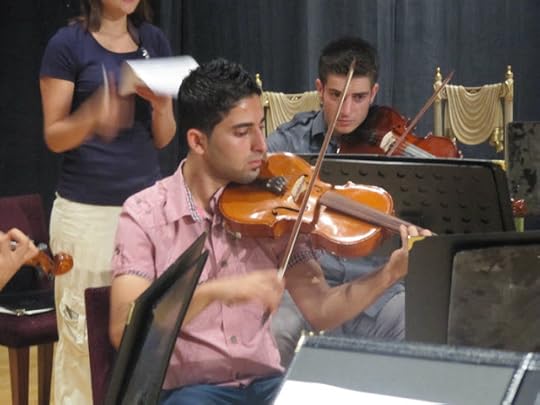
Saad Al Saedi, our concertmaster in 2011, claimed asylum in Dortmund with his family.
Alan and Daroon Abdulrazaq Rasheed (violin & viola) teach and perform in Erbil, Kurdistan.
Chia Sultan (bass), studied Masters in Bass in Italy.
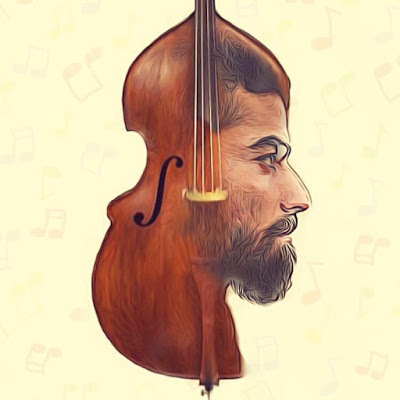
Almujtaba Al Waeli (trumpet) is now a professional translator in Baghdad.

Samir Basseem (bass) and his wife emigrated to America, where he now works and plays bass.
Bashdar Sdiq studied Masters in Cello Performance at Western Michigan University, where he founded Orchestra Routh, a youth orchestra for children seeking asylum.

Hellgurd Sultan (viola) and his wife moved to Germany when he won a scholarship with the Deutsche Akademische Austausch Dienst (DAAD), where he studied early childhood education. They now live in Cologne.
Lewis Hermiz (violin) our 2012 Arab concertmaster, fled for his life when ISIS invaded Mosul in 2014. He's now reestablished his life in Kurdistan.

Saman Hiwa (translator) also received a DAAD scholarship and is now doing post-doctoral research at the University of Freiburg. He is a fully qualified doctor.
Shwan Aziz (translator) still lives in Suleymaniyah, where he runs an Italian logistics company.
The German Friends of the National Youth Orchestra of Iraq, having failed to resurrect the orchestra after its last concert in 2013, are now sitting in their comfort zone, and managed this year to bring two players to Germany for four days of teaching. Their treasurer, Georg Witteler, sued the German publisher of UPBEAT for using two of his photos and an email without his permission, so one assumes they currently have no financial worries.
The orchestra’s NGO in Baghdad has also failed to resurrect the orchestra.
Zuhal Sultan recently got Waleed to organise music classes with refugee kids in Kurdistan, and turned up with a photographer to direct them. She too has failed to resurrect the National Youth Orchestra of Iraq.
There are many angles to this story which I explore in my book. The one area I didn’t touch upon, but which is increasingly apparent to me, is the division of class between myself, the orchestra, and its far from competent bourgeois management. Coming from a lower middle class background, I grew up on getting results through blood, sweat and tears. I can now see just how little some in the orchestra management were willing to get their hands dirty, whilst forcing my hand to carry much of the hard work, responsibility and risk, in order to compensate for them. Should Iraqis feel entitled to help from Western governments and NGOs? Absolutely, as the West largely created this mess. But should anyone have felt entitled to mine?
The sustainable result of the National Youth Orchestra is not the orchestra itself, but rather twofold: a handful of individual musicians in Iraq with a perspective nurtured through those five years together, and those who got out to start a better, safer, more musical life elsewhere. Both groups have the power to shape Iraq’s culture by stealth.
The Iraqi Government has moved up the league table of Transparency International, and is now only the 10th most corrupt country in the world. This is a government with a 2016 budget of $94 billion and no debts, which offered $15,000 to the orchestra in 2012, whose corruption and apathy I subsidised with the hard work that kept their national youth orchestra alive. As the failed state of Iraq moves into a post-ISIS world, it has to redefine what it is, and heal its wounds. This must be done not just through infrastructure, but also education and culture.
Alan Kamil – our concertmaster from 2013, is studying Masters at the Royal College of Music in Stockholm.

Dua’a Al Azzawi, (oboe), Ranya Nashat, Ali Mahdi, Mohammed Saad (horns), Murtada Aziz (trumpet), Mohammed Adnan, Ali Al Ghabban, Annie Melconian (violins), Ahmed Abbas (bassoon), Tuq’a Al Waeli, Hussam Ezzat (cellos) continue to play in concerts of the Iraqi National Symphony Orchestra in Baghdad. Hussein, our Baghdad clarinettist from 2013, claimed asylum in Finland.

Murad and Burcu Saffar (bassoons) got married and now live with their son in Turkey.

Mariwan Ismael (clarinet) did a runner in 2011 after Beethovenfest, and is now believed to be living in Sweden. He was the only one we "lost".

Frand Nashat is a professional translator in Baghdad and still plays his trumpet, most recently in a masterclass in Germany.

Waleed Assi teaches and plays flute in Suleymaniyah.

Boran Zaza (piano) studies piano at the Schulish School of Music at McGill University, Quebec and is one half of the piano duo, Duo Columbus.

Siamand Mohammed (bass), Zana and Rezhwan Jalal (violin & viola), Rebaz Sdiq (violin), Awder Mahmood, Hersh Mohammed (cello), Peshawa Mohammed (percussion) and many others still perform in Suleymaniyah, Kurdistan.
Shirwan Mohammed (violin, viola, daff) claimed asylum in Vancouver.

Saad Al Saedi, our concertmaster in 2011, claimed asylum in Dortmund with his family.
Alan and Daroon Abdulrazaq Rasheed (violin & viola) teach and perform in Erbil, Kurdistan.
Chia Sultan (bass), studied Masters in Bass in Italy.

Almujtaba Al Waeli (trumpet) is now a professional translator in Baghdad.

Samir Basseem (bass) and his wife emigrated to America, where he now works and plays bass.
Bashdar Sdiq studied Masters in Cello Performance at Western Michigan University, where he founded Orchestra Routh, a youth orchestra for children seeking asylum.

Hellgurd Sultan (viola) and his wife moved to Germany when he won a scholarship with the Deutsche Akademische Austausch Dienst (DAAD), where he studied early childhood education. They now live in Cologne.
Lewis Hermiz (violin) our 2012 Arab concertmaster, fled for his life when ISIS invaded Mosul in 2014. He's now reestablished his life in Kurdistan.

Saman Hiwa (translator) also received a DAAD scholarship and is now doing post-doctoral research at the University of Freiburg. He is a fully qualified doctor.
Shwan Aziz (translator) still lives in Suleymaniyah, where he runs an Italian logistics company.
The German Friends of the National Youth Orchestra of Iraq, having failed to resurrect the orchestra after its last concert in 2013, are now sitting in their comfort zone, and managed this year to bring two players to Germany for four days of teaching. Their treasurer, Georg Witteler, sued the German publisher of UPBEAT for using two of his photos and an email without his permission, so one assumes they currently have no financial worries.
The orchestra’s NGO in Baghdad has also failed to resurrect the orchestra.
Zuhal Sultan recently got Waleed to organise music classes with refugee kids in Kurdistan, and turned up with a photographer to direct them. She too has failed to resurrect the National Youth Orchestra of Iraq.
There are many angles to this story which I explore in my book. The one area I didn’t touch upon, but which is increasingly apparent to me, is the division of class between myself, the orchestra, and its far from competent bourgeois management. Coming from a lower middle class background, I grew up on getting results through blood, sweat and tears. I can now see just how little some in the orchestra management were willing to get their hands dirty, whilst forcing my hand to carry much of the hard work, responsibility and risk, in order to compensate for them. Should Iraqis feel entitled to help from Western governments and NGOs? Absolutely, as the West largely created this mess. But should anyone have felt entitled to mine?
The sustainable result of the National Youth Orchestra is not the orchestra itself, but rather twofold: a handful of individual musicians in Iraq with a perspective nurtured through those five years together, and those who got out to start a better, safer, more musical life elsewhere. Both groups have the power to shape Iraq’s culture by stealth.
The Iraqi Government has moved up the league table of Transparency International, and is now only the 10th most corrupt country in the world. This is a government with a 2016 budget of $94 billion and no debts, which offered $15,000 to the orchestra in 2012, whose corruption and apathy I subsidised with the hard work that kept their national youth orchestra alive. As the failed state of Iraq moves into a post-ISIS world, it has to redefine what it is, and heal its wounds. This must be done not just through infrastructure, but also education and culture.
Published on September 16, 2017 04:34



